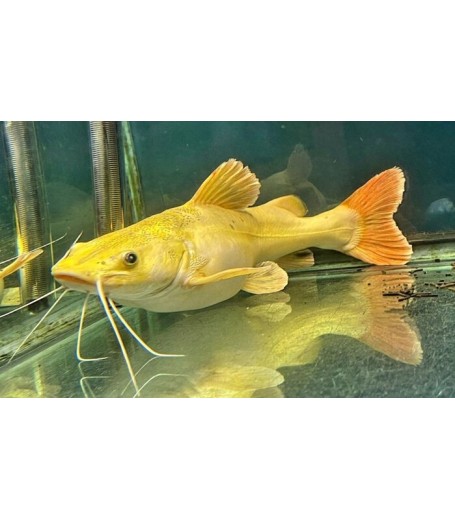GOLDEN PATIN CATFISH
- RM0.00
Origin
Redtail catfish (Phractocephalus hemioliopterus) are found in the Amazon, Orinoco, and Essequibo river basins of South America, which span across Ecuador, Venezuela, Brazil, Colombia, and Peru. These bottom-dwelling fish are common in the wild and thrive in large rivers and streams.
Adult Size & Lifespan
In the wild, fully-grown redtail catfish reach up to six feet in length and can weigh up to 180 pounds. Due to their enormous size, redtail catfish are often treated as game fish by anglers. Captive redtail catfish are three to four feet long on average.
Juvenile redtail catfish are small — only a few inches — but grow rapidly. There are no known size differences between male and female fish. Redtail catfish have an average lifespan of 15 years in captivity but live longer in the wild.
Colors, Patterns, Fins, and Sex Difference
The redtail catfish has a grayish-brown, spotted body with a red tail. The dorsal and caudal fins are orange in coloration, and the fish has long barbels (whiskers) on its mouth. A pale yellow band spans across its body.
The redtail catfish is slender and has a flat underbelly. They aren’t sexually dimorphic, meaning it’s impossible to tell females and males apart. When stressed, redtail catfish lose their vivid tail coloration.
Typical Behavior
Redtail catfish are bottom-dwelling fish that prefer to live alone. These fish won’t hesitate to attack smaller species, and they often exhibit territorial aggression if there are too many fish in the aquarium. Juvenile redtail catfish are shy and require lots of hiding spots to feel at ease.
Redtail catfish are slow swimmers and spend most of their time in the bottom regions of the tank. They are rarely active during the day.
Despite their voracious appetites and predatory nature, these fish are peaceful when kept with the right tank mates and in the appropriate tank conditions.
Tank Conditions
Keep redtail catfish in the following tank conditions:
| Water type: | Freshwater, with weekly changes (30% of water volume) Redtail catfish are messy eaters and often displace substrate, so frequent water changes are essential |
| Tank size: | Minimum 1,500-gallon aquarium for mature fish. Juveniles should be moved to larger tanks as they grow |
| Water temperature: | 70–79°F (21–26°C) |
| Substrate: | None. Redtail catfish may try to eat substrate |
| Tank setup: | Add a few decorations to provide hiding spots Decorations should be sturdy and durable so they can’t be displaced or eaten. Avoid driftwood and small rocks. Tie any loose decorations down. |
| Acidity: | 6.0–7.5 pH |
| Water hardness: | Moderately soft water, between 3–12 dGH |
| Filter and heater: | Sump-style filter and external heating system. An external system is necessary to prevent the fish from damaging or eating it. Check daily for blockages Avoid filters that generate a powerful current because redtail catfish are accustomed to slow-flowing water |
| Bubbler: | Not necessary |
| Pump: | Yes, to provide water movement for gas exchange |
| Lighting: | Dim lighting, as the fish become stressed if exposed to harsh, direct lighting. If a dimly-lit environment isn’t available, create shaded areas with caves for the redtail catfish to retreat to |
Monitor water parameters and test nitrate and ammonia levels regularly. Redtail catfish often surface to gulp air in poor water conditions.
Tank Mates
Suitable tank mates for the redtail catfish include:
- Gars
- Large stingrays
- Large datnoids
- Iridescent sharks
- Bichirs
Avoid invertebrates like shrimps and crabs because redtail catfish eat anything that can fit in their mouths. Keeping redtail catfish with other tank mates requires an immensely large aquarium — larger than most hobbyists can realistically provide and afford.
Diet and Feeding
Redtail catfish are omnivores that require a protein-rich diet. In the wild, redtail catfish eat anything they can find, including crustaceans, small fish, insects, and fruit.
Ideal foods for the redtail catfish include sinking pellets and both live and frozen foods like shrimp, crayfish, small fish, and worms.
As a general rule, adults should be fed on a weekly basis. However, reduce or increase feeding frequency based on the fish’s activity level. These fish become sluggish after a meal, and should only be fed when they become active again.
Reviews
There are no reviews for this product.



